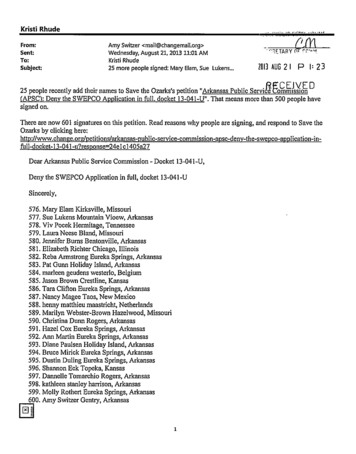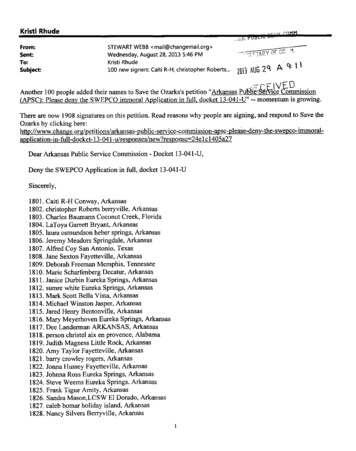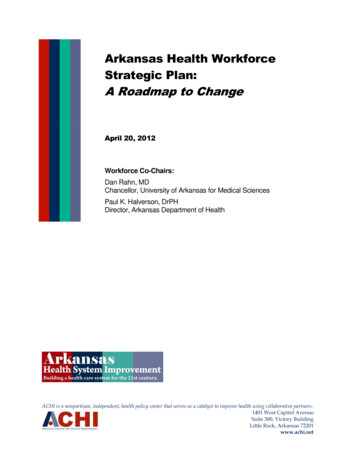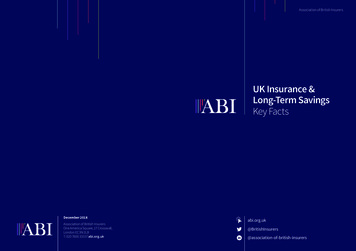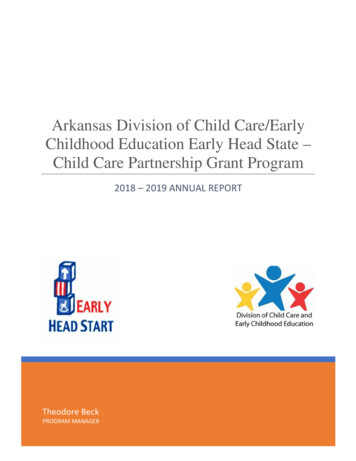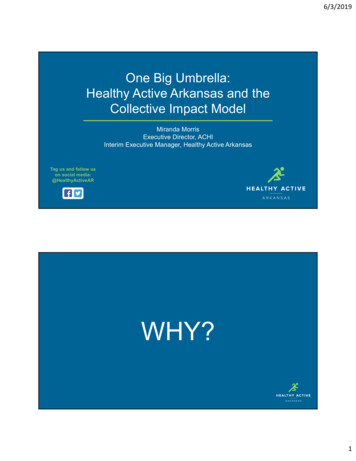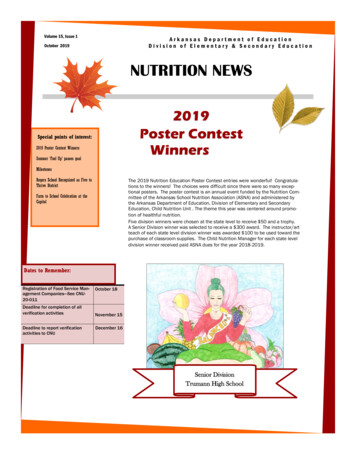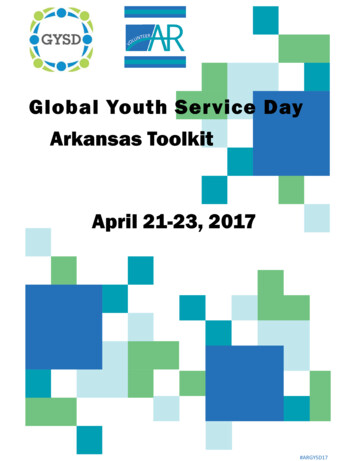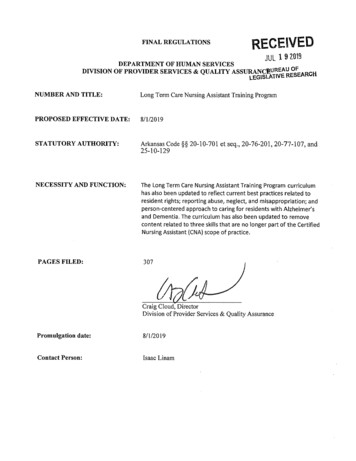
Transcription
STATE OF ARKANSASLONG TERM CARE FACILITY NURSING ASSISTANT TRAINING CURRICULUMWritten byThe Curriculum Committee for theNursing Assistant Training ProgramJuly 1988(Revised July 1992)(Revised July 2006)(Revised January 2019)For information and implementation of this curriculum contact:Quality Assurance, Workforce Assessment, & Provider EngagementDivision of Provider Services and Quality AssuranceDepartment of Human ServicesPost Office Box 8059 Slot S405Little Rock, Arkansas 72203Page 1 of 307
AUTHORITYI.1.The following rules and regulations for the Long Term Care Facility NursingAssistant Training Program are duly adopted and promulgated by theDepartment of Human Services pursuant to Arkansas Code 20–10–701 et seq.2.This initiative is pursuant to the Federal mandates of Public Law 100–203The Nursing Home Reform Act, Subtitle C of the Omnibus Budgetand Reconciliation Act of 1987 and technical amendments of OBRA1989 and 1990 concerning the training and competency evaluation ofnursing assistants employed in long term care facilities and theregistry of certified nursing assistants.3.The Federal Omnibus Budget Reconciliation Act (OBRA) of 1987, 1989, and1990 and regulations issued by the U.S. Department of Health and HumanServices – Centers for Medicare and Medicaid Services (formerly Health CareFinancing Administration, or HCFA) established the minimum requirements fornursing assistant training and competency evaluation programs in Section1819(a) – (f) and 1919(a) – (f) of the Social Security Act.II.1.The Arkansas Nursing Assistant Scope of Practice identifies the Standards ofPractice that Certified Nursing Assistants (CNA) must follow in delivering care. Ifa CNA delivers care outside of the defined Standards of Practice, whether it is onthe CNA’s own initiative or at the direction of a licensed nurse, the CNA mayhave violated the Arkansas Adult and Long–Term Care Facility ResidentMaltreatment Act as defined in Arkansas Code Ann. 12–12–1707 et seq.Page 2 of 307
TABLE OF CONTENTSLesson #1Introduction to the Role of the Nurse Aide . 11I.Introduction to Long Term Care . 17II.The Role of the Nurse Aide . 17III.The Care Team and the Chain of Command. 19IV.Communication and Interpersonal Skills . 19V.Resident-Centered Care (Person-Centered Care) . 22Lesson #2Resident Rights . 23I.Resident Rights . 24II.Abuse, Neglect, and PersonalPossessions/Misappropriation . 26Lesson #3Infection Control . 29I.Introduction to Infection Control. 32II.Infection Control Practices. 35III.Hand Hygiene . 36IV.Personal Protective Equipment – PPE . 37V.Precautions . 37Lesson #4Fire Safety and Other Resident Safety Concerns . 39I.Fire Safety . 39II.Side rails/Entrapment . 41III.Resident Elopement . 41IV.Smoking . 43Lesson # 5Medical Concerns/Emergency Procedures . 45I.Accidents . 46II.Falls / Fall Prevention . 46III.Choking . 47IV.Burns/Scalds . 48V.Poisoning. 49VI.Medical Emergency . 49VII.Safety Measures/Prevention Strategies . 50Page 3 of 307
Lesson #6Basic Care Skills. 52I.Points to Remember . 54II.Unoccupied Bed . 55IV.Resident Room/Environment/Fall Prevention . 55V.Promoting Proper Nutrition and Hydration . 56Lesson #7Common Diseases and Disorders – Respiratory andUrinary Systems . 63Respiratory System . 63I.Respiratory System . 63II.Common Conditions of the Respiratory System . 63III.Normal Changes with Age . 64IV.Role of the Nurse Aide regarding the Respiratory System . 64Urinary System. 65I.Urinary System . 65II.Common Conditions of the Urinary System. 65III.Normal Changes with Age . 65IV.Problems Caused by Incontinence . 65V.Role of the Nurse Aide regarding the Urinary System . 65Lesson #8Oxygen Use . 67I.Oxygen Use . 67Lesson #9Common Diseases and Disorders – Nervous, Circulatory andMusculo–Skeletal Systems . 71Nervous System . 72I.Nervous System . 72II.Conditions that Affect Nervous System . 72III.Normal Nervous System Changes with Age . 73IV.Role of the Nurse Aide regarding the Nervous System . 73Circulatory System . 74I.Circulatory System . 74II.Conditions that Affect the Circulatory System . 74III.Normal Circulatory Changes with Age . 74IV.Role of the Nurse Aide regarding Circulatory System . 74Page 4 of 307
Musculoskeletal System . 75I.Musculoskeletal System . 75II.Conditions that Affect Musculoskeletal System . 75III.Importance of Exercise or Range of Motion (ROM) . 76IV.Normal Musculoskeletal Changes with Age . 77V.Role of the Nurse Aide regarding the MusculoskeletalSystem . 77Lesson #10Common Diseases and Disorders – Gastrointestinaland Endocrine Systems . 79Gastrointestinal System . 80I.Gastrointestinal System. 80II.Common Conditions of the Gastrointestinal System . 80III.Normal Changes with Age . 80IV.Role of the Nurse Aide regarding the GastrointestinalSystem . 80Endocrine System . 81I.Endocrine System . 81II.Common Conditions that Affect the Endocrine System . 81III.Normal Changes with Age . 82IV.Role of the Nurse Aide regarding the Endocrine System . 82Lesson #11Common Diseases and Disorders – Reproductive,Immune/Lymphatic Systems . 84Reproductive System . 85I.Reproductive System . 85II.Common Conditions that Affect the Reproductive System . 85III.Normal Changes with Age . 85IV.Role of the Nurse Aide regarding the ReproductiveSystem . 85Lymphatic and Immune Systems . 85I.Lymphatic System . 85II.Immune System. 85III.Common Conditions of the Immune and LymphaticSystems. 86IV.Normal Changes with Age . 86Page 5 of 307
V.Role of the Nurse Aide regarding the Immune andLymphatic Systems . 86Lesson #12Activities of Daily Living - Bathing, Shampoo,Perineal Care . 88I.Bathing and Shampooing Points to Remember . 88II.Perineal and Catheter Care Points to Remember .89Lesson #13Activities of Daily Living - Oral Care, Grooming, NailCare . 91I.Lesson #14Grooming/Personal Hygiene . 91Activities of Daily Living - Dressing, Toileting . 94I.Dressing . 95II.Toileting . 95Lesson #15Activities of Daily Living – Positioning/Turning,Transfers . 100I.Proper positioning and body alignment . 101II.Commonly used positions . 102III.Proper transfer . 103Lesson #16Activities of Daily Living - Devices Used for Transfer. 108I.Mechanical lifts . 108II.Transfer resident to stretcher/shower bed . 109III.Transfer – Two Person Lift . 110Lesson #17Resident’s Environment . 111I.Lesson #18Occupied Bed .111Skin Care/Pressure Prevention . 113I.Understanding the Integumentary System and Basic SkinCare. 114II.Risk Factors for Skin Breakdown . 116III.Pressure Ulcer Development . 118IV.Prevention of Skin Breakdown . 118Lesson #19Activities of Daily Living Nutrition/Hydration . 121I.Promoting Proper Nutrition and Hydration . 121II.Promoting the Use of Proper FeedingTechnique/Assisting a Resident with Special Needs . 122III.Caring for a Resident with a Tube Feeding and theResident at Risk for Aspiration . 124Page 6 of 307
Lesson #20Basic Nursing Skills – Vital Signs, Height and Weight . 127I.Initial Steps . 128II.Final Steps . 128III.Vital signs Provide Important Information . 128IV.Measuring Height and Weight . 130Lesson #21Restraints . 133I.Physical Restraint . 134Lesson #22Rehabilitation/Restorative Services. 138I.II.III.Rehabilitation .138Restorative Services .139Devices which may be applied per Restorative NursingProgram. 139Lesson #23Devices/Interventions - Prosthetics, Hearing Aides,Artificial Eye, Eyeglasses, Dentures, CompressionStockings . 141I.Purpose of a Prosthetic Device . 141II.Types of Prosthetic Devices . 141III.Role of the Nurse Aide regarding Amputations &Prosthetic Care . 142IV.Role of the Nurse Aide regarding Hearing Aids . 142V.Role of the Nurse Aide regarding Artificial Eye &Eyeglasses . 142VI.Role of the Nurse Aide regarding Dentures . 143VII.Role of the Nurse Aide regarding Elastic/CompressionStockings (TED Hose) . 143Lesson #24Special Care Needs – Intravenous Fluids, Non–Pharmacologic Pain Interventions . 145I.IV or PICC Lines . 146II.Role of the Nurse Aide in caring for IV/PICC . 146III.Infection Control . 147IV.Pain Factors . 147V.Role of the Nurse Aide related to Pain . 147Lesson #25Cognitive Impairment/Dementia/Alzheimer’s . 151I.Conditions . 152II.Behaviors, Causes and Interventions . 155Page 7 of 307
III.Methods/Therapies to Reduce Behaviors. 158IV.Tips to Remember when Dealing with CognitivelyImpaired Residents. 159V.Communication Strategies . 159VI.Techniques to Handle Difficult Behaviors . 159VII.Behavior Interventions . 160VIII.Activity Chart . 163IX.Safety Checklist . 165X.Sleep Changes . 167Lesson #26Mental Health, Depression and Social Needs . 171I.Causes of Mental Illness . 172II.Response to Behaviors . 172III.Use of Defense Mechanisms – unconscious behaviorsused to release tension or cope with stress oruncomfortable, threatening situations or feelings. . 173IV.Types of Mental Illness . 173V.Behaviors Associated with Mental Disorders – actionsand interventions . 175VI.Treatment for Mental Illness . 175VII.Special Considerations . 176VIII.Mental Illness and Intellectual Disability . 176Lesson #27Admission/Transfer/Discharge . 177I.Admitting a New Resident to the Facility . 177II.Assisting to Transfer a Resident to a Hospital (i.e., CareTransition) . 178III.Assisting a Resident to Discharge Home or to AnotherFacility . 178Lesson #28End of Life . 179I.Advance Directives . 179II.Role of Hospice . 180III.Care of the Dying Resident . 180IV.Signs/Symptoms of Impending Death . 181V.Post Mortem Care . 181VI.Disposition of Personal Belongings . 182Page 8 of 307
VII.Stages of Reaction to Dying . 182Lesson # 29Daily Responsibilities . 185I.Day-to-day Time Management/Resident Care . 185II.Interdisciplinary Care Plan Meetings . 186Lesson #30Protecting Your Profession . 188I.Reducing Stress/Burnout. 189II.Abuse/Neglect/Misappropriation . 190III.Nurse Aide Testing/Certification . 191IV.Certification Renewal. 192V.Course Review . 192Works Cited. .193APPENDIX ASupplemental Materials .195APPENDIX BAnswers to Review Questions. .199APPENDIX CCare Skills. 207APPENDIX DTask Performance Record .302Page 9 of 307
UNIT 1Page 10 of 307
Lesson # 1 (1 hour)Title: Introduction to the Role of the Nurse AideLesson Objectives:I.The student will be able to describe Long Term Care in comparison with otherhealthcare settings.II.The student will be able to describe the role of the Nursing Assistant, includingthe Scope of Practice and the role of facility policies and procedures which maygovern care and conduct.III.The student will be able to explain the members and roles of the InterdisciplinaryCare Team and the Chain of Command.IV.The student will be able to describe the importance of both verbal and non–verbal communication, barriers to effective communication, and interpersonalskills.V.The student will be able to explain culture change/resident-centered care and theneed to incorporate into daily care.Key Terms:Abuse – any intentional unnecessary physical act that inflicts pain on, or causes injury,to an endangered person or an impaired person (nursing home resident);A. Any intentional and unnecessary physical act that inflicts pain on or causesinjury to an endangered person or an impaired person, excluding courtordered medical care or medical care requested by the patient or long-termcare facility resident or a person legally authorized to make medical decisionson behalf of the patient or long-term care facility resident;B. Any intentional act that a reasonable person would believe subjects anendangered person or an impaired person, regardless of age, ability tocomprehend, or disability, to ridicule or psychological injury in a manner likelyto provoke fear or alarm, excluding necessary care and treatment provided inaccordance with generally recognized professional standards of care;C. Any intentional threat that a reasonable person would find credible and nonfrivolous to inflict pain on or cause injury to an endangered person or animpaired person except in the course of medical treatment or for justifiablecause; orD. Any willful infliction of injury, unreasonable confinement, intimidation, orpunishment with resulting physical harm, pain, or mental anguish.Page 11 of 307
Activity Director (AD) – an individual who plans the activities for the residents andassists them to socialize and to stay physically and mentally active.Activities of Daily Living (ADLs) – personal daily care tasks, including bathing,dressing, caring for teeth and hair, toileting, eating, and drinking.Acute – a current illness that has severe symptoms and may be as a result of a suddenonset.Administrator – manages all departments within the facility.Adult Day Care – care given at a facility during day time hours; generally for individualswho need some assistance and/or supervision but are not seriously ill or disabled;usually reside outside of the facility.Advanced Practice Nurse – a registered nurse having education beyond the basicnursing education and certified by a nationally recognized professional organization in anursing specialty, or meeting other criteria established by a Board of Nursing.Assisted Living – facilities where residents live who need limited assistance, but do notrequire skilled care.Bedfast – Bedridden. Confined to bed, especially for a long or indefinite period of time,due to illness or injuryCall Light – a device used to communicate a need for assistance to staff.Certified Nursing Assistant (CNA) – an individual who has completed a stateapproved course and has successfully completed certification testing. A CNA providesdirect care under the supervision of a Registered Nurse (RN) or a Licensed PracticalNurse (LPN).Certified Occupational Therapist Assistant (COTA) – helps patients develop,recover, and improve the skills needed for daily living and working. Occupationaltherapy assistants provide therapy to patients under the direct supervision ofoccupational therapists.Chain of Command – the line of authority in the facility which addresses to whom eachemployee/department reports.Chronic – the disease or condition is long term or will be long lasting.Clichés – phrases that are used frequently and which often have a different meaning,making it difficult for the resident to understand.Communication – the process of exchanging information with others.Page 12 of 307
Criminal Record Check – the process of reviewing an individual’s criminal history inorder to determine if he/she is eligible for employment in a long term care facility. Stateand/or national records may be reviewed for this process.Cultural Differences – beliefs, values, habits, diet and health practices that relate to aperson’s culture or religion.Cultural Diversity – the variety of people living and working together in the facility.Culture – the way of life, especially the general customs and beliefs, of a particulargroup of people at a particular time.Culture Change – a philosophy that focuses on providing person–centered care toresidents and creating a positive work environment for healthcare workers.Denial – rejection of a thought or feeling.Dependent – requires staff assistance to carry out activities of daily living.Displacement – transferring a strong negative feeling to something or someone else.Endangered Adult – A long-term care facility resident or an Arkansas State Hospitalresident who:A. Is found to be in a situation or condition that poses an imminent risk of deathor serious bodily harm to the long-term care facility resident; andB. Demonstrates a lack of capacity to comprehend the nature andconsequences of remaining in that situation or condition.Exploitation – illegal or unauthorized use or management of an endangered person’sor an impaired person’s (nursing home resident) funds, assets, or property;A. Misappropriation of property of a long–term care facility resident, that is, thedeliberate misplacement, exploitation, or wrongful, temporary, or permanentuse of a long–term care facility resident’s belonging or money without thelong–term facility resident’s consent.Health Insurance Portability and Accountability Act (HIPAA) – federal law thatprotects the privacy of individually-identifiable health information; sets nationalstandards for the security of electronic, protected health information; and protectsidentifiable information being used to analyze patient safety events and improve patientsafety.Home Health Care – care provided in a person’s home.Hospice Care – care for individuals who have an estimated six months or less to live.Hospice provides physical and emotional care and comfort.Page 13 of 307
Housekeeping Department – responsible to maintain the facility in a clean andsanitary manner.Impaired Person – a person eighteen (18) years of age or older who as a result ofmental or physical impairment is unable to protect himself or herself from abuse, sexualabuse, neglect or exploitation. A long–term care facility resident is presumed to be animpaired person.Independent – able to carry out activities of daily living without staff assistance.Intermediate Care Facilities/Individuals with Intellectual Disabilities (ICF/IID) –facilities that specialize in providing care to developmentally disabled individuals.Interdisciplinary Team – professionals from each discipline within the nursing facilitywho meet to discuss and plan the care of the resident.Laundry Department – oversees laundering of facility linens and residents’ personalclothing.Licensed Practical Nurse (LPN) – A licensed professional who has completed 1 to 2years of nursing education and has passed an exam for licensure; nurse who providescare under the direction of registered nurses or physicians.Long Term Care (LTC) – care for persons who require 24-hour care and assistance.Long Term Care Facility Resident – means a person, regardless of age, living in along–term care facility.Long Term Care Facility Resident Maltreatment – abuse, exploitation,misappropriation of a resident’s property, neglect, or sexual abuse of a long–term carefacility resident as defined by Arkansas law.Maintenance Department – maintains facility and grounds in good repair.Medical Director – physician who provides oversight to the nursing staff regarding careprovided to the residents.Medical Doctor (MD) – physicianMedication Assistive Person (MAP) – a certified nursing assistant who has completedrequired state training and has completed examination in an effort to administermedications and certain treatments in accordance with the specific scope of practice ofthe MAP.Neglect – an act or omission by a caregiver responsible for the care and supervision ofan endangered person or an impaired person (nursing home resident) constituting:Page 14 of 307
A. Negligently failing to provide necessary treatment, rehabilitation, care, food,clothing, shelter, supervision, or medical services to an endangered person oran impaired person;B. Negligently failing to re
1. The Arkansas Nursing Assistant Scope of Practice identifies the Standards of Practice that Certified Nursing Assistants (CNA) must follow in delivering care. If a CNA delivers care outside of the defined Standards of Practice, whether it is on the CNA’s own initia
